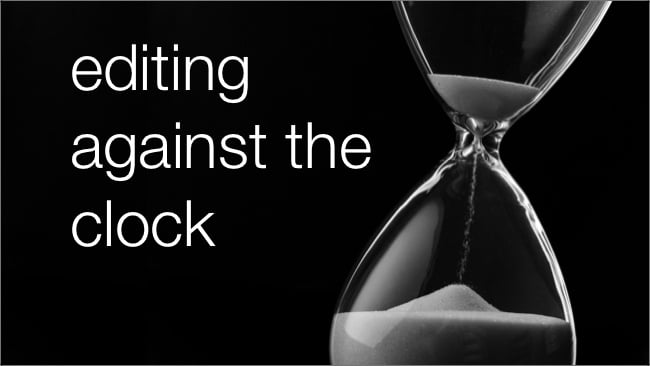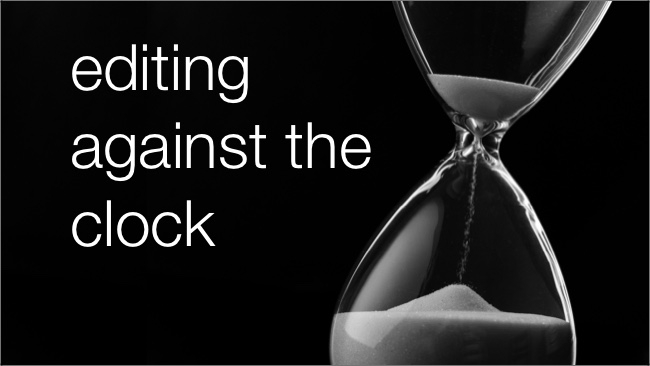

RedShark Replay: How would you go about editing a film that would normally take three days, in just three hours? Jonny Elwyn has some cogent advice.
Editing to a tight deadline can be an uncomfortable experience. It can be hard to get a project to a place where you’re happy with it, and meet all the client’s requests and deliver on time. Working under pressure often leads to not thinking as clearly as you otherwise would.
In the immortal words of Mark Wahlberg in Shooter: “Slow is smooth, smooth is fast.”
In my experience, focusing on a few key things, and doing those slowly and methodically is the best way to get the project delivered quickly. Here are my tips for editing to a tight deadline.
Briefing Before Busting
Taking the time to sit down and really nail the brief with the client, producer or director is absolutely crucial to editing and delivering a project to a tight deadline, because there won’t be the time for the usual back and forth that occurs when a client ‘will only know it, when they see it’.
It doesn’t have to be a complicated process, even taking the time to write a three line script for your beginning, middle and end of the film will really help to clarify what you’re going to say, and in what order.
The danger with diving in and editing with ‘aggressive randomness’ is that you might find interesting comments in the interview that aren’t actually on message, or put in too much of one character when another person is more important.
This kind of prep might not look or feel like real work, especially when there are files waiting to be ingested, interviews to hack down and music libraries to trawl through, but remember Mark’s words. Slow is smooth, smooth is fast.
Structure First, Wallpaper Second, Snag Third
Like building a house you want to get all the walls up first, then tackle the wallpaper and finally comb through the ‘snags’ at the end. You don’t want to be moving a wall you just spent an hour papering.
Similarly you need to start your edit by focusing on getting the structure locked down then adding in cutaways and music, and finally paying attention to perfecting the grade and mix if you have time.
If I’m cutting a film that’s essentially one or two main interviews, covered by cutaways, with a music bed underneath (which covers a good percentage of most corporate or charity videos), then I always start with the main interview to build my film’s structure, then add in the second interview and stop to see if what I have works as a story.
Client feedback at this point is a good time saving step, as long as they’re savvy enough to watch a ‘bald’ version of the film, with jump cuts and gaps all over the place, without freaking out.
Next I’ll cut the music in to time and make sure the pacing is correct. Only then will I put in the cutaways to illustrate the key points and cover my cuts. Effectively by this point I’ve got a version that’s watchable, if not perfect.
The final task is then to fix the grade, polish the mix and add in any extra graphics or sound design that will really lift the piece. It can be tempting to attend to these things too early, maybe because you want the client to see something that looks nearly finished, but you’ll end up saving time if your hard work ends up hitting the cutting room floor.
Keep a Short Feedback Loop
One of the things that will make the biggest difference when editing to a tight deadline is to have the client right there with you, able to feedback and sign off at each stage.
Knowing that the interview material is structured correctly and has all the key messages in it, before you dive into creating the rest of the film, can only be confirmed by who ever is signing off on the film.
Rather than emailing over a cut, if you can sit down with the client as soon as it’s done, and point at the screen and move things around, test out other clips etc. you’ll get to the right result, faster.
Keeping a short feedback loop also helps keep clients involved and aware of the projects progress which has the added benefit of stopping them from over reaching within the limitations of the deadline. If they ask “Can we do ___________.” You can say yes we can, but we’ll miss the deadline, which is most important?
In Conclusion
Everything I’ve suggested could easily be applied to editing a project where there is plenty of time to work at a more leisurely pace but when you’re editing to a tight deadline there is no room for mistakes due to miscommunication. These simple steps will help you to deliver the project on time and with less stress.
Hourglass pic: shutterstock.com
Tags: Post & VFX


Comments